How to achieve "universal" chain abstraction through diversified stack
The convenience and choice that Netflix’s move from physical DVD rentals to digital and streaming services enabled it to surpass Blockbuster.
 JinseFinance
JinseFinance
Original title: Abstracting Chains
Author: Shlok Khemani, Decentralised.co; Translator: 0xjs & 0xxz@黄金财经
Before the main text begins...
Over the past few months, chain abstraction has become one of the most discussed topics in the crypto space, and for good reason. No industry expert would argue that the current state of hundreds of fragmented blockchains is ideal.
However, when people try to understand the topic, they are faced with a slew of jargon - intent, solver network, liquidation layer, and order flow auction. Even for writers like us who think we are well-versed in cryptocurrency, it becomes a little difficult to understand. We need help.
Vaibhav Chellani is the founder of Socket, the first chain abstraction protocol. Vaibhav has been thinking about blockchain expansion for nearly a decade. As a member of the Ethereum Foundation, he participated in building the first ZK rollup. He also served as the Head of Protocol at Polygon, an Ethereum-to-Polygon facilitator of scaling when it needed it most. There, he spearheaded the development of the Ethereum-to-Polygon bridge, which is now valued at over $5 billion.
Vaibhav has seen the rollup, scaling, and bridge space evolve firsthand. He foresaw the multi-chain, multi-bridge future we find ourselves in now, and the UX challenges it would present for users and developers. He founded Socket in 2022 to address these issues.
To gain a deeper understanding of chain abstraction, we collaborated with Vaibhav and the Socket team. This article is the result of that collaboration.
While it can be dangerous to reason by analogy, today’s crypto landscape bears a striking resemblance to the internet of the early 1990s.
Back then, America Online (AOL) was often referred to as “the training wheels for the internet.” Users spent hours on the platform sending emails, creating real and imagined characters, discussing niche topics, sharing pictures, and playing games. By 1995, AOL had more than 3 million users, its stock price had soared nearly 2,000% in three years, and its brand had become iconic in pop culture. It achieved all this despite its inability to keep up with growing demand.
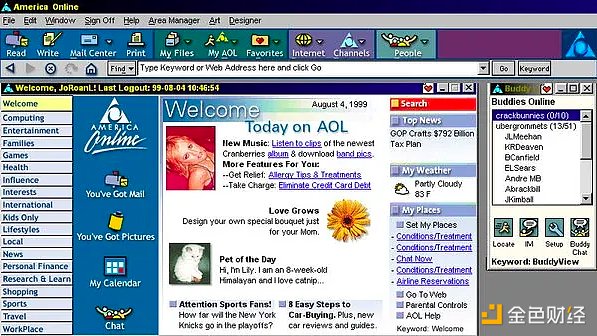
A version of the AOL homepage, the internet’s first “super app.”
Despite its early success, however, AOL was not open. It was a closed computer network that required users to install separate software and subscribe to AOL's Internet Service Provider (ISP). And AOL was far from exclusive. CompuServe, IBM's Prodigy, Microsoft's MSN, AT&T's Interchange Online Network, and Apple's eWorld all employed similar proprietary software, network, and ISP models to compete for the same prize.
The situation could be a nightmare for users. If you used AOL and wanted to chat with friends on CompuServe, one of you had to pay for an additional subscription. In addition, each network was vying to provide exclusive media content to its subscribers. The New York Times partnered with AOL, and the Wall Street Journal with CompuServe, and access to both required separate subscriptions and connections.
Fortunately, the situation was short-lived. While these companies were plotting to monopolize the web and dominate, a team of Swiss researchers led by Tim Berners-Lee and a motley crew of college students at the University of Illinois led by Marc Andreessen were developing a different vision. They envisioned a community-driven web governed by universal standards, open to all for anyone to access or develop. The portal to this web? A web browser.
Today, we simply call it the Internet.
Open, flexible (HTML format allows users to freely create), and standardized, the Internet thrives on network effects and user-generated content. Once the Netscape Navigator browser was introduced, the Internet quickly became the network of choice for users and developers. Slowly at first, then suddenly, the AOLs of the world realized that their walled gardens could not compete with this behemoth and had to adapt reluctantly.
The Internet unified the fragmented landscape and sparked the greatest technological movement in history.
Today, in the cryptocurrency space, we have hundreds of different blockchains and rollups, each with their own wallets, applications, liquidity, users, standards, and culture, all operating in silos. Despite attempts to bridge these silos, the experience remains clunky. This fragmentation leads to a poor user experience and limits the appeal of cryptocurrency to a wider audience.
Such differences in ideology, implementation, and approach are characteristic of early technologies as developers are still figuring out which approaches work best. However, as the technology matures and scales, so does the need for standardization and consolidation. Crypto is now at a critical juncture, transitioning from the realm of early adopters and geeks to a tool for the masses.
The industry has recognized this need, and a movement called “chain abstraction” has emerged to address it. While the vision of chain abstraction (making the user experience in Web3 as seamless as Web2) is simple, achieving it is not.
In today’s post, we’ll explore the current state of the multi-chain world, the problems it creates, efforts to address these problems so far, and the role of chain abstraction and socket solutions in all of these areas. Finally, we discuss the future, where chain abstraction will lead to a major shift in the way cryptocurrency value is accumulated, completely changing the industry.
Let’s get started!
Disclaimer: This article discusses the user experience problems of cryptocurrency in detail and analyzes them from the perspective of absolute newcomers - the type of users that make up the “masses” we want to join cryptocurrency. If you are a cryptocurrency native, you may not resonate too strongly with these issues.
In the beginning, Bitcoin was a revolutionary technology that introduced the world to blockchain and its unprecedented properties: decentralization, censorship resistance, and distributed ledgers. While Bitcoin was primarily focused on payments, its open source codebase opened a Pandora’s box for other technological experiments. These early experiments included specialized blockchains such as Namecoin, Dogecoin, and Litecoin.
Then came Ethereum, a Turing-complete blockchain that allowed developers to create any application they could envision using a universal global ledger. This sparked a wave of innovations — from stablecoins to decentralized finance to gaming and intellectual property — that grew at an exponential rate. However, Ethereum soon began to suffer from its own success, with the influx of activity leading to high fees and long wait times.
General-purpose blockchains need to scale. Solutions come in two forms.
The first solution is to scale Ethereum itself through a layer 2 solution (L2), or Rollup. L2 is designed to process transactions outside of the main blockchain while still leveraging its security by publishing concatenated proofs on the main blockchain. Even within L2, there are multiple approaches; some, like Arbitrum and Optimism, use optimistic proofs, while others, like ZKSync and Starknet, use ZK proofs. In the process, Ethereum itself formally adapted to a Rollup-centric roadmap.
The second solution was to break away from Ethereum entirely and build scalability from scratch.This vision was embraced by teams like Solana, Near, and Cosmos, who created new blockchain architectures with unique design choices and execution environments. Soon, other teams like Sui and Aptos followed suit and built their own stacks with similar approaches.
Both Ethereum scaling solutions and alternative blockchains attracted hundreds of millions of dollars in capital and traded for billions on the open market. This wealth creation naturally attracted more builders, leading to more blockchains. But these newer projects needed to stand out in some way.
Some differentiated themselves through technology (different variants of ZK proofs or higher-level programming languages), while others differentiated themselves through specific use cases (decentralized storage or gaming).
A new trend then emerged — distributed applications building their own chains. One of the early examples was Axie Infinity, a top Web3 game on Ethereum, which built Ronin — their own blockchain. Coinbase, one of the world’s largest exchanges, released Base, and Blur, a top Ethereum NFT marketplace, released Blast — both Ethereum L2s.
Major NFT projects like Pudgy Penguins, meme coins like Shiba Inu, and financial products like Ribbon have also adopted this approach. Recently, we’ve even seen the rise of L3s — chains that exist on top of L2s.
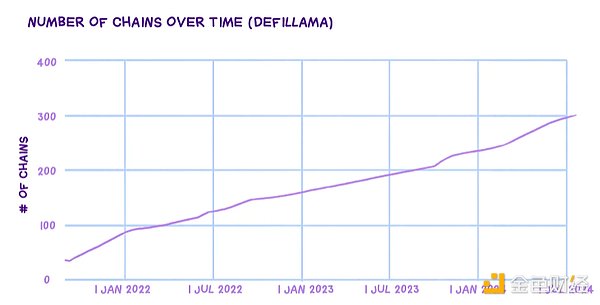
Data: DefiLlama
These developments mean that there are at least 300 active blockchains in crypto today (DefiLlama tracking) and more than 80 upcoming blockchains (L2 beat tracking). Neither source is comprehensive, so I suspect the actual number is much higher.
Nevertheless, we have seen a Cambrian explosion of blockchains over the past two years, and there are several reasons to believe that this proliferation will not slow down anytime soon. I’ve listed some of them below.
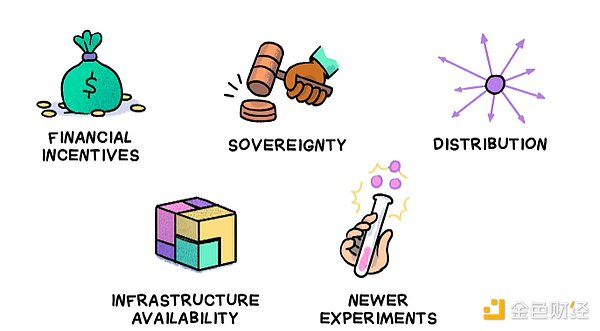
The fat protocol theory states that “the market value of a protocol will always grow faster than the total value of the applications built on it.” So far, this has largely held true—most of the value in crypto has accumulated at the blockchain layer. This means that investors and market value the infrastructure layer is higher than the application layer. Therefore, the financial incentive for new and old application builders is to create or migrate to a separate chain.
Universal chains require applications to share block space with other applications, and their users must pay gas fees in the blockchain’s native token. This becomes a problem during periods of high demand, as a surge in activity in one application can affect other applications. Additionally, if an application has its own token, its users must hold both that token and the native token to pay for gas, leading to a worse user experience.
Moving to a separate blockchain allows for sovereignty over both block space and tokens. Pudgy Penguins, one of the few crypto brands with mass adoption (they’ve sold over a million toys), is building its own chain to “vertically integrate from IP to base layer.”
Successful businesses are built on moats, and few moats are stronger than broad distribution. Projects initially launch on general-purpose blockchains to leverage their existing distribution. Successful projects build their own large user base. If that happens, they can accrue more value by transitioning to their own chain and letting other projects leverage their distribution. The success of Axie Infinity led Sky Mavis to launch Ronin, which has since evolved into a standalone gaming chain.
The need for builders to create chains has led to the commoditization of the chain infrastructure itself. A few years ago, building a blockchain required bootstrapping a validator base or having the technical skills to build an L2. Since then, the barriers have been greatly reduced.
The combination of data availability solutions like Celestia, security solutions like EigenLayer, open source SDKs from Optimism, Arbitrum, and Polygon, and Rollup-as-a-Service platforms like Gelato have made blockchain creation relatively simple.
Blockchain fundamentals innovation is still ongoing. Teams continue to experiment with new designs. Monad is creating an Ethereum-Solana hybrid. MegaEth is experimenting with “streaming transactions at lightning speeds.” Additionally, chains like Solana and Bitcoin that traditionally didn’t support Rollups are now seeing teams building Rollups on them.
In other words, all signs point to us heading toward a world with thousands of blockchains.
The multi-chain world driven by financial, commercial, and technological incentives has already fragmented the industry in many ways.
Liquidity is at the heart of healthy financial markets. The more liquid a market is, the easier it is to trade. Highly liquid DEX pairs can offer better prices (reduced slippage) when making trades. Highly liquid lending pools help make borrowing and lending safe and easy.
Liquidity is a network effect play. Highly liquid pools are more attractive to investors and increase the utility of the tokens that make up the pool, leading to higher liquidity. This is why liquidity pools in protocols like Uniswap and Aave follow a power law, where the top pools are orders of magnitude larger than smaller pools.
When capital is fragmented across chains, liquidity and its benefits also become fragmented. For example, the most efficient pool for an ETH-USDC swap may exist on Ethereum. However, if you want to make the same swap on Base, you will not be able to benefit from these lower prices.
One of the reasons why smart contract blockchains like Ethereum are game-changing technology is because of their composability. Developers can combine and interact with different protocols, applications, and assets seamlessly. This enables developers to build complex solutions without having to start from scratch.
I maintain two Google Chrome profiles - one for personal stuff and one for work stuff. Many times, I will accidentally open YouTube in my work profile and see an unexpected set of recommendations, or I will look for a work bookmark in my personal profile and then find out that it doesn't exist.
Each profile maintains its own history, extensions, saved passwords, connected accounts, etc. This is what state fragmentation looks like.
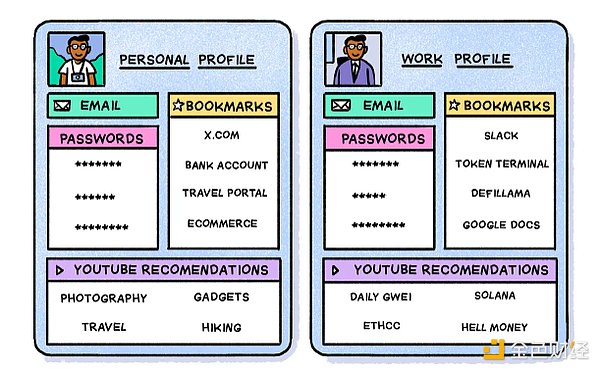
When working within the scope of a single chain, an aggregator can browse prices from multiple DEXs without permission and provide users with the best execution. Or, lending protocols could offer users loans for high-value NFTs. USDY (Ondo’s T-Bill-backed stablecoin) was previously just a yield-yielding stablecoin sitting idle in a wallet. But when DeFi protocols like Drift allow it to be used as collateral for perpetual contract transactions without permission, the asset becomes more attractive to users. This composability breaks down between blockchains. Users can’t buy NFTs on Ethereum with USDC on Base in a single transaction. Developers can’t leverage assets on one chain to offer users products on another chain. Cryptocurrency is inherently tribal. Driven by financial incentives, communities band together to cheer on projects so that they succeed (and the value of their holdings increases). This also leads to an “us vs. them” mentality, or maximalism. Bitcoin’s maximalist user base wants nothing to do with other blockchains. Solana’s largest user base is more likely to try Blinks on Solana than Time Dot Fun on Base.
The greater the number of chains, the more room there is for this maximalism. This leads to a fragmentation of users and culture.
These trends are problematic for developers. The reality is that no single chain is great at everything. Each chain has its weaknesses and strengths. So how do they choose where to build? Factors like application cultural fit, programming language familiarity, funding grants, and technical strengths all come into play. However, by choosing to build on just one chain, developers miss out on the user base of other chains. On the other hand, users won’t experience the application that’s best suited for their use case, regardless of which chain they’re on.
The fragmentation caused by blockchain silos is by no means a new problem, but one that the industry has been grappling with for years. My colleague Saurabh likes to use a metaphor that thinks of these isolated blockchains as closed islands, each with its own citizens, culture, and assets. For any activity to take place between these islands, they need to be connected in some way.
Crypto bridges function similarly to real-world bridges, connecting different blockchains and allowing for seamless movement of assets and data. When a user wants to transfer an asset from chain A to chain B, at its core the bridge does the following:
It allows the user to deposit the asset in chain A.
It asserts on chain B that the asset has been securely received in chain A.
It unlocks the user’s asset in chain B.
Now, how a bridge accomplishes these steps, especially the second step, can vary greatly depending on the mechanics of the bridge. Much has been written about bridge design (and its risks and security vulnerabilities), so I won’t discuss them here. Furthermore, they are not relevant to the purpose of this article.
What we do need to know is that bridges exist, are one of the most well-funded areas in the cryptocurrency space, have matured over time, and come in many forms. So why is everyone making all the fuss about this chain abstraction? Aren’t blockchains connected? Doesn't the bridge solve the fragmentation problem? Also, don't users have a lot of choices too? That should be a good thing, right? Well, not exactly.
Consider this scenario: Martin is new to crypto, and his favorite artist just released a new work as an NFT on Optimism for 0.1 ETH (about $300). Martin asks his crypto native friend Joel to wire him some funds. However, Joel only has USDC on Base. Because Martin is in a hurry (it's a limited edition mint), he asks Joel to wire him the funds and he'll find a way to buy it. Martin may not be that familiar with crypto yet, but he's tech savvy. How hard can it be?
It turns out it's actually hard. Here are the steps he has to follow.

That’s at least 10 steps and 28 separate clicks. I’m being lenient here and assuming Martin has a wallet set up and can use the same wallet to connect both chains and find the information he wants (how to pay for gas, the right bridge, the right DEX) in one go. That’s not counting the miscellaneous steps of signing and transaction confirmation in the wallet. For a complete beginner, this would be a nightmare. Using funds from another chain to buy an NFT on this chain (one of the most basic user flows in crypto) shouldn’t be rocket science.
We live in a world of abundant choice but scarce attention span. Consumers lack the patience to wait even a few extra seconds. Web2 developers know this well. They are obsessed with reducing user complexity by reducing clicks. Metrics like conversion rates and session length are measured with scientific precision.
Amazon realized this over 30 years ago and patented “one-click checkout”, a key breakthrough that led to its dominance in e-commerce. The best companies pay designers millions of dollars to simplify their products.
While this kind of thinking is largely absent from Web3 products today, it also reflects the nature of early technology. Ford’s Model T, the first mass-produced car, was slower than a running horse. Early computers took up entire buildings. For a long time, they were text-based with no graphics. The first “mobile” phone weighed 2 kg. As I mentioned before, the internet was also very slow and clunky at first (if there were images, they were loaded line by line).
The fact that we have tens of millions of on-chain users navigating these complex mazes to use crypto products is pretty amazing when you think about it. (This also speaks to how powerful financial incentives are, if that needs explaining!)
But the tide is turning. After years of investing in infrastructure, we now have enough block space. Next, we’ll make crypto more accessible, more user-friendly, and more scalable. Projects, researchers, builders, and investors are slowly but surely coordinating to build a better, smoother, more Web2-like experience in Web3. Such drastic changes don’t happen overnight. It’s an incremental process with many moving parts.
The end goal? To reduce the number of clicks required for Martin to mint an NFT to 1. To achieve this, we’ll first need to simplify the bridge.
The process of finding a bridge, bridging assets, and redeeming the desired tokens on the target chain is one of the most common user flows in crypto. But it’s also incredibly complex for newcomers.
First, finding a bridge itself isn’t easy. There are multiple options, including native and third-party bridge solutions. Martin might find that while a particular bridge supports Optimism, it doesn’t yet support the newer Base chain. Additionally, each bridge makes tradeoffs between speed, security, and fees. For smaller transactions, users might optimize for speed or fees. But if they’re moving millions of dollars, they’ll prioritize security.
Once you’ve bridged an asset, you must also exchange it for the token you want. This also requires finding a DEX, paying the gas fee, and making the exchange. To make matters even more painful for users, some bridges don’t provide users with the native token on the target chain (like USDC), but instead provide an unofficial copy of the original token (like USDC.e).
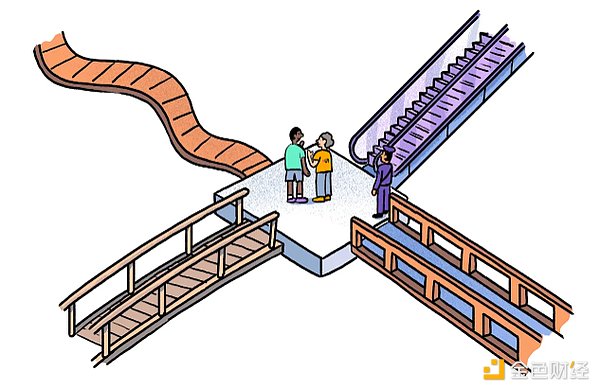
Socket initially aggregated existing bridges and DEXs into a single meta-bridge. The simple goal is to provide users with a range of options to go from asset X on chain A to asset Y on chain B, based on their preferences for cost, latency, and security. They do this using a combination of on-chain smart contracts and an off-chain routing algorithm that dynamically selects the best bridge or route.
Socket has split this technology into two products.
The Socket API is for developers who want to provide a cross-chain experience for their users. It is used by platforms like Zapper and Zerion, wallets like Coinbase Wallet, Rabby, MetaMask, and Rainbow, and DeFi applications like Brahma.fi.
Polymarket, a consumer prediction market app that has surged in popularity over the past year, also uses the Socket API. While the app is built on Polygon and accepts USDC deposits, users may have funds on other chains like Ethereum. Instead of requiring users to bridge from Ethereum to Polygon separately, the Socket API helps integrate these steps seamlessly.
Bungee is the consumer version of the Socket metabridge. It allows users to bridge and swap in a single interface without having to perform all the steps we discussed previously separately.
For example, when Martin wants to exchange 300 USDC on Base for ETH on Optimism, he enters these parameters on Bungee. The protocol helps him find the best transaction bridge among the four options. Based on his preference, he can complete the bridge and swap on Bungee.
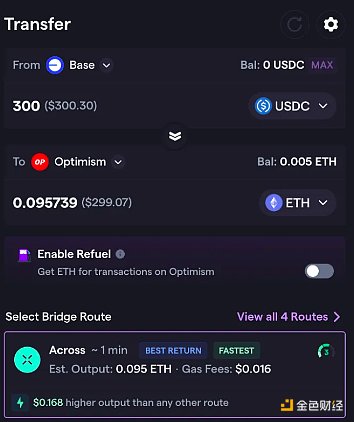
This is how he buys NFTs now. The number of clicks has been reduced by nearly half! It’s still too complicated, but we’re making progress.
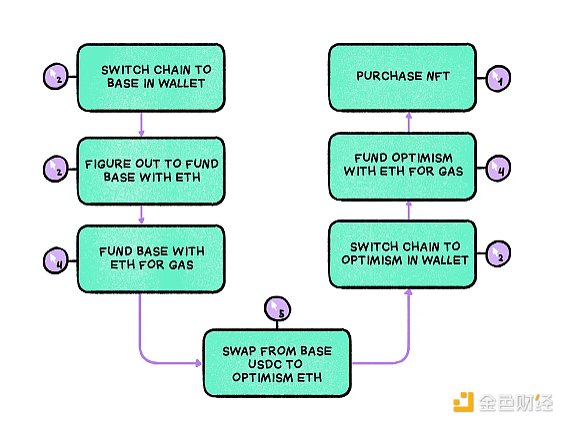
Bungee is also flexible. If a user wants to transfer $1 million USDC from Base to Optimism, they may not trust a third-party bridge with such a large amount and may need stronger security. In this case, they can use Circle's (USDC issuer) native CCTP bridge.
Bungee Exchange and Socket API jointly provide cross-chain exchange services for more than $12 billion for the 16 (and growing) chains it supports.
Other teams tackling cross-chain bridging and swapping include Li.Fi and DeBridge.
Crypto native users who own a gas token on another chain, such as ETH, may want to consider bridging their tokens. However, bridging can be costly and slow, depending on the bridge used.
Socket offers an alternative through its service “Refuel.” Refuel uses indexers and liquidity pools to provide native tokens for gas on different chains. For example, a user with ETH on the mainnet needs MATIC to pay Polygon to deposit ETH into the Refuel contract. The centralized relayer confirms the transaction and funds the user’s wallet with MATIC. Refuel only charges the destination gas fee, making it a cheaper and faster (albeit centralized) alternative to bridging gas tokens.
But what about crypto newbies who don’t understand gas fees?
Most popular crypto wallets like MetaMask and Phantom are Externally Owned Accounts (EOA). In simple terms, this means that a user’s account exists outside of the blockchain state. EOA is not a good fit for crypto user experience for the following reasons:
Users must manage their own private keys. If their keys are lost or compromised, they risk losing access to all of their funds.
Users must hold the blockchain’s native token to pay for their gas fees.
Users can only sign one transaction at a time.
These limitations were ultimately addressed by a common standard: ERC-4337, commonly referred to as account abstraction.We discussed account abstraction in detail in a previous post, so I’ll only touch on the parts that are relevant to this post.
Account abstraction relies on the concept of smart contract accounts (SCAs). SCAs are deployed as accounts on the blockchain as smart contracts. This means that user interactions with the wallet are part of the blockchain state. Instead of signing transactions, users sign messages called “opcodes” which are then processed by specialized actors called “bundlers.”
Among other things, account abstraction alleviates a major pain point in the cryptocurrency user experience: gas fees. New cryptocurrency users like Martin find the concept of gas fees strange. It’s like asking users to sign up with a credit card before they can start using Facebook — it’s really unthinkable. Yet, every blockchain transaction does require gas fees. If it’s not the user, can we get someone else to pay for it?
Account abstraction enables the sponsorship of gas fees on behalf of users by introducing a new actor in the transaction supply chain — the paymaster. Paymasters charge a fee and can either allow applications to sponsor gas fees on behalf of users or allow users to pay for gas fees in the token of their choice.
For Martin, this means that he can pay for the gas fees of his swaps with USDC without having to buy ETH separately on Base. Similarly, NFT applications can now sponsor gas fees on his behalf, or allow him to pay with USDC on Optimism.
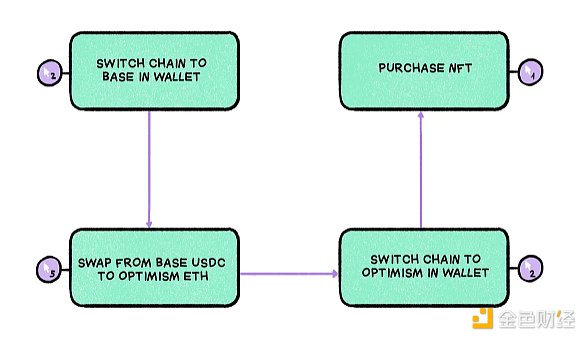
Now it’s just 4 steps and 10 clicks!
Both cross-chain swaps and account abstraction have significantly improved the cryptocurrency user experience. However, we have not yet reached the ultimate goal of one-click minting.
When bridging from one chain to another, even with an aggregator like Bungee, users must choose a source chain and a target chain among many options. This is feasible if there are only a few major chains, as we encountered before. However, if the number of chains reaches hundreds or thousands, the user experience starts to degrade. Furthermore, once users bridge funds, they still have to switch between different chains in their wallets to use those funds.
The root of both of these problems is that users are forced to think of their crypto experience as one across different chains. Their assets are on one or more chains, and the application they want to interact with is on another. This idea is inherently complex. After all, blockchains are just underlying ledgers. Users shouldn’t have to think about which servers or databases developers choose to build on when interacting with Web2 applications.
A world with an ever-increasing number of blockchains is also problematic from a bridge scaling perspective. Recall that the second step in a bridge’s operation is to assert on chain B that an asset has been received on chain A. By its design, the bridge does this by creating a messaging framework between chain A and chain B, deploying contracts so that each chain can understand these messages, and then using relays to pass messages from one chain to the other.
This mechanism is problematic because these messaging systems must be deployed separately between each pair of chains. For example, if a bridge currently supports five chains and wants to add one more, a messaging system must be deployed between the five chains and the new chain. In other words, the bridge scales quadratically - for n chains, there will be n squared connections. Once you exceed a certain number of chains, cross-chain scaling becomes infeasible.
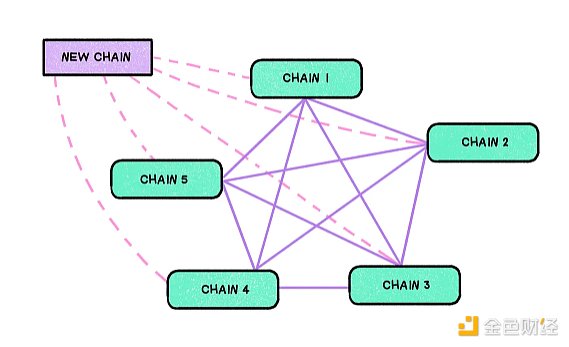 Now, the solution is obvious: "chain abstraction". Users should interact with blockchain applications, not the underlying chain where the funds are located or the application is built. Martin should learn about his NFT minting site, not Base, Optimism, or a bridge or bridge aggregator from one site to another.
Now, the solution is obvious: "chain abstraction". Users should interact with blockchain applications, not the underlying chain where the funds are located or the application is built. Martin should learn about his NFT minting site, not Base, Optimism, or a bridge or bridge aggregator from one site to another.
From a developer’s perspective, they need a way to move beyond existing bridge solutions that don’t scale. They need buy-in from participants that help them move funds from chain A to chain B, regardless of whether there is a messaging system between them.
Chain abstraction is not a set of processes or products, but an end goal, with multiple paths (each with a set of trade-offs) to achieve it. However, the commonality between these implementations is the existence of “intention” and “solver networks”. These have become buzzwords around the topic of chain abstraction. Let’s understand what they mean.
Users perform on-chain activities to move from the current state to a desired end state. For example, Martin wants to move from 300 USDC on Base to an NFT on Arbitrum. In the current state of cryptocurrency, we leave it up to users to decide how to reach the end state. This takes the form of them interacting with a specific smart contract that meets their exact needs.
This situation is not always ideal for two reasons:
As we have seen repeatedly, the steps to get to a final state can become extremely complex even for simple use cases.
Even if a user does find a path that helps them get to a final state, it may not always be optimal.
For example, imagine a user who wants to swap $1 million USDC on one chain for USDT on another chain. They could either use an existing bridge and swap solution directly, or interact with a protocol like Bungee to help them do the swap. However, it is also possible that there is an off-chain participant (perhaps a market maker with a lot of liquidity on a centralized exchange) who is willing to provide them with the swap service at a lower fee than either solution.
The user does not benefit from this, resulting in market inefficiencies.
Intents are a completely different way to think about crypto trading. The premise is the same - the user wants to get to a certain final state. However, by using intents, a group of experienced participants compete to help them reach the end state, rather than figuring out how to get to that end state. Intents mean that all Martin has to do is express his desire to mint NFTs on Optimism, and not spend more than 300 USDC, and these participants (also known as solvers) will help him achieve this goal.
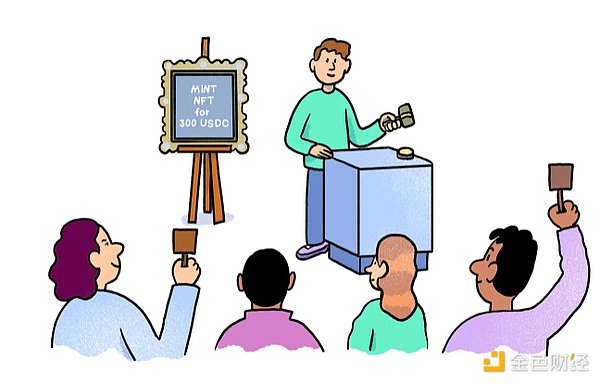 Here's an example to help you better understand intent. Joel wants to go from Brooklyn to Manhattan. Fifteen years ago, he would have to go out on the street and flag down passing taxis to stop. Some taxis are already full of passengers and won't stop. Maybe no taxis pass by, and Joel needs to walk to a busier street in the rain. Once he gets in the taxi, he may have to help the driver with directions. This is what crypto looks like today - dozens of steps through a lot of uncertainty to get to a final state.
Here's an example to help you better understand intent. Joel wants to go from Brooklyn to Manhattan. Fifteen years ago, he would have to go out on the street and flag down passing taxis to stop. Some taxis are already full of passengers and won't stop. Maybe no taxis pass by, and Joel needs to walk to a busier street in the rain. Once he gets in the taxi, he may have to help the driver with directions. This is what crypto looks like today - dozens of steps through a lot of uncertainty to get to a final state.
Intents are like using Uber. Joel can sit in the comfort of his home, say his exact destination, browse different options to get there, get a price quote and estimated time in advance, track the progress of his trip, get in the car when he arrives, and get to his exact destination without any communication with the driver.
Uber has greatly improved the experience and convenience beyond the status quo. Intents promise the same improvement for on-chain transactions.
So, how do intents work? Below is a general framework for a simple cross-chain exchange.
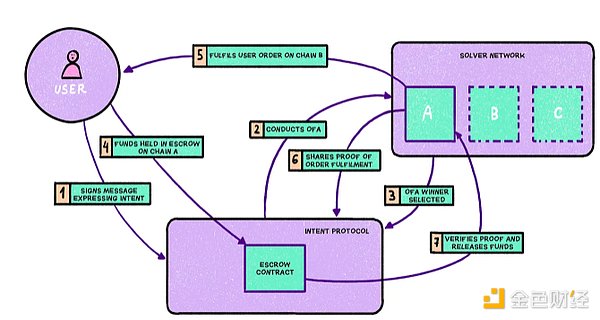
The Intention Protocol then holds an auction, called the Order Flow Auction (OFA), where solvers compete to satisfy this intention.
Based on the auction design (which we’ll discuss in detail shortly), the protocol selects a solver and holds 300 USDC on Base as escrow.
The selected solver leverages its own liquidity to fulfill the user’s 0.1ETH order on Optimism by providing upfront capital.
Once completed, the solver shares a proof with the protocol.
The protocol releases the escrowed funds and settles with the solver.
Because this is a general framework of intent, the implementation of each step in this process may vary depending on the team or protocol building the solution.
For example, OFA can be designed in a variety of ways based on the following choices:
Where are orders shared? Orders can be posted in a public memory pool visible to everyone, in a private memory pool powered by technology such as TEEs, or with only partial intent details.
Who can be a solver? The list of solvers can be open to anyone, restricted to a specific selected set, or only one solver can be chosen for a period of time, giving them exclusive access.
How are winners chosen? The winner of the auction can be determined based on different criteria, such as the fastest solve time, the lowest user fee, or the largest inclusion guarantee.
You can read more about the OFA auction design space here.
Similarly, the validation process by which the intent protocol verifies that a solver has fulfilled a user's order can also be implemented in different ways:
Optimistic validation. Once a solver claims to have fulfilled an order, there is a challenge period. If no one challenges the solver's claim during this period, they are free to claim the escrowed funds.
Messaging system. Once a solver deposits funds, a message is passed from the target chain to the source chain. Existing messaging solutions provided by the cross-chain protocol can be used for supported chains.
Light Clients. Light clients are simplified versions of full nodes that allow users to verify transactions without downloading the full ledger. A light client for the target chain on the source chain can help verify solver fulfillment.
ZK Proofs. Zero-knowledge proofs (which are easy to verify and cannot be forged) are another way to prove order fulfillment.
Even the settlement process (i.e. releasing locked funds to the settler after verification) can have different mechanisms. Some protocols only allow settlers to settle on the source chain, while others allow more flexibility. Some protocols settle individual transactions, while others settle in batches.
A range of protocols are tweaking these parameters to create their own intentional solutions. These include Across, DLN, UniswapX, and Anoma, among others. We even have dedicated solutions for specific layers of this stack. Everclear is focused solely on making settlements as efficient as possible. Khalani Network helps solvers coordinate and collaborate to complete complex orders.
The industry is excited about intent and OFA as a solution to the problem of cryptocurrency fragmentation and complex user experience because it changes the role of users in the ecosystem. Instead of being left to fend for themselves in the cryptocurrency wilderness, users are in a state where incentivized participants help them achieve their goals.
Recall that developers building OFA need to grapple with a variety of design choices based on their specific use case - auction design, verification and settlement mechanisms, allowed participants, and so on. However, building OFA from scratch can be very inefficient and resource-intensive for a variety of reasons.
First, once developers decide on their solution design, they must deploy both on-chain and off-chain code for it. Given that these networks will be processing high-value transactions, they require high security guarantees. Developing such technology can be costly, time-consuming, and risky. In addition, even small changes in protocol design require significant incremental resources.
Secondly, OFA relies on solvers, i.e., specialized off-chain participants, to operate. It can be difficult and time-consuming for a new protocol to bootstrap a solver pool. In the initial stages, there won’t be much activity on a new protocol, so it won’t be attractive to unincentivized solvers (this is a classic cold start problem). Moreover, since different intent networks will use different mechanisms, solvers must create solutions for each network separately, which further increases friction.
Third, many applications may not need the services of dedicated solvers. Their needs can be met by the participation of existing participants in the transaction supply chain, such as validators, sorters, block builders and proposers, packagers, and payers. In addition, they may not want to introduce new message types in the form of intents, but use regular transaction or account abstraction opcodes.
The Socket team has a first-hand observation of this evolution. As an early participant in the cross-chain space, they have witnessed the proliferation of chains and the real-time emergence of intents and OFA. They believe that we are still in the early stages of this paradigm (current solutions are limited to specific use cases like exchanges), that intent-powered user experiences will be a key component of crypto mass adoption, and that there will be various intent networks to meet different user needs.
No longer just a cross-chain aggregator, Socket is now building the first chain abstraction protocol. Their goal is to transform a world with 10,000 Rollups into an all-in-one experience for users.
The core of the protocol is MOFA (Modular Order Flow Auctions).
MOFA provides developers with the tools to create order flow auctions and implement their own design choices while remaining neutral. You can think of each design choice as a separate Lego brick, and MOFA is the solution that allows developers to mix and match the bricks to build the intent network of their choice.
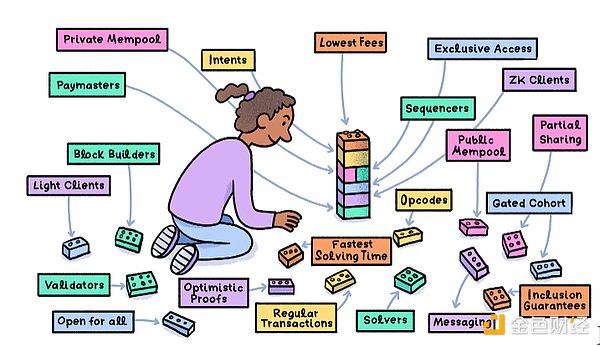 By simplifying the creation of flexible intent solutions, MOFA significantly reduces the development and maintenance time and cost of new protocols. In addition, since all networks created with MOFA are derived from the same building blocks, existing solvers can relatively easily build solutions for and serve newer intent networks.
By simplifying the creation of flexible intent solutions, MOFA significantly reduces the development and maintenance time and cost of new protocols. In addition, since all networks created with MOFA are derived from the same building blocks, existing solvers can relatively easily build solutions for and serve newer intent networks.
Therefore, MOFA also helps protocols solve the cold start problem by providing an open marketplace for networks and solvers. (This can be thought of as similar to the role played by EigenLayer in blockchain security.)
MOFA also rethinks the subject matter of participants that make up the solver set. In most existing intent network designs, solvers are specialized off-chain participants whose functions are separate from on-chain participants such as validators and sequencers. MOFA expands the solver set to include validators and sequencers, and calls this expanded set of participants “transmitters.”
To understand the importance of this, we need to understand the concept of “reorganization risk.” My colleague Saurabh explained reorganization in a previous post.
For a blockchain like Bitcoin, many miners are racing to find new blocks. Sometimes, more than one miner may succeed. Suppose two miners find new blocks (#1000A and #1000B) at height 1000. Due to propagation delays, some nodes will see block #1000A while other nodes will see block #1000B. Now, if a new block is found on top of block #1000B, the chain that block #1000B is on will become the longest chain, and block #1000A will be discarded or reorganized by the network.
Note that it is possible that the third block #1000C is discovered by another miner at the same height (1000), and two more blocks (#1001 and #1002) are discovered by the same miner or by other miners building on this block. In this case, both blocks #1000A and #1000B are discarded, and #1000C becomes part of the chain. Ethereum also faces reorganizations, but they are rarely more than one block deep.
Recall that solvers commit to prepay funds to satisfy user intent and receive settlement after a verification delay. Consider a situation where a solver has just completed an order on the target chain, but has not yet received the user’s escrowed funds on the source chain. The risk here is that the source chain is reorganized at some point before the user’s escrowed funds.
In this case, the user ends up with funds on both the source chain (where the reorganization returns the funds) and the target chain (where the solver has deposited the funds), with the solver facing a loss.
For solvers, such a reorganization is a huge risk. Reorganizations, especially in newer and untested chains, are fairly common. The Degen chain, one of the first notable L3s, recently experienced a reorganization of over 500,000 blocks! As the number of new chains increases, these risks will only intensify for solvers.
So how do you eliminate (or at least reduce) the risk of a reorganization? MOFA’s solution is to directly allow validators and sorters to become solvers. Validators and sorters are the participants responsible for the blockchain’s block construction mechanism. Since they have the most visibility into valid and invalid blocks and reorganization risk, they are best suited to bear the reorganization risk. Another benefit of having them as resolvers is that they can include transactions directly in blocks, making intent resolution faster.
In the purest sense, chain abstraction means that users are completely unaware of the existence of a blockchain. Their funds may be spread across multiple chains, but only one balance is shown. They shouldn’t have to pay for native gas tokens on different blockchains. Finally, any cross-chain transaction, like Martin minting an NFT, should be as easy as a Web2 interaction — one click, instant result.
Socket recently launched a framework called MagicSpend++ (inspired by Coinbase’s Magic Spend) that allows developers to create seamless user experiences using MOFA and account abstraction. Here’s how MagicSpend++ works to mint an NFT for Martin.
Martin uses a smart contract wallet that shows him a single chain abstraction balance.
Martin clicks “Mint NFT”.
The payee service checks if Martin's smart wallet (cross-chain) has enough balance for minting. Payees participate in auctions created using MOFA.
When creating a userOP, the payee not only sponsors gas, but also funds the purchase of NFTs on the target chain. (Thus, the payee acts as a solver.)
Once the userOP is completed and the NFT is delivered to Martin, the payee will be able to withdraw funds from the vault.
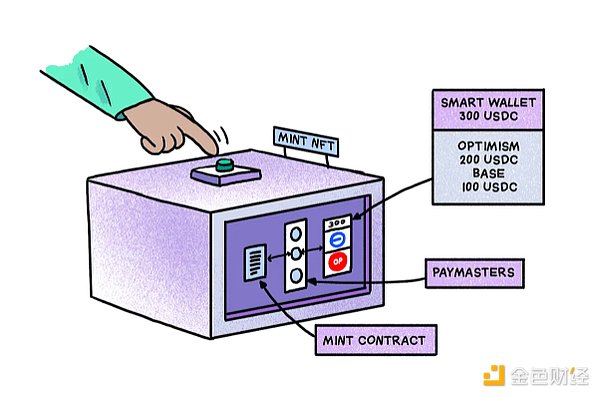
Martin can finally mint his NFT with one click!
Magic-Spend++ is essentially a “spend first, charge later” protocol that aims to leverage the widespread account abstraction infrastructure that has been launched to achieve chain abstraction. This vision attracted teams such as ZeroDev, which are already well-known account abstraction service providers, to implement Magic-Spend++ in practice.
Magic-Spend++ represents a shift in perspective from a chain-centric to an account-centric one. This approach, where wallet solutions adapt to make the cryptocurrency user experience smoother, is also being implemented by other teams in the ecosystem, such as Near Protocol, Particle Network, and OneBalance.
So far, our discussion of chain abstraction has focused on solving the crypto user experience problem. However, this is only one side of the chain abstraction coin. On the other side, there exists an approach that can completely change the way we think about scaling blockchain applications. Let me explain.
Today, developers deploy smart contracts for their applications on a single blockchain. When Yuga Labs launched the Otherside series on the Ethereum mainnet, it led to severe congestion and gas price increases. At the time (more than two years ago), the multi-chain ecosystem was still in its infancy. Even if they chose to deploy on other chains, they had no easy way for users to move their NFTs back to the mainnet if they wanted to.
However, in the world of chain abstraction, these limitations no longer apply. Since there is no longer a distinction between chains, there is no concept of a user belonging to one chain and not another. Every user will belong to every chain. In addition, it has become easier to transfer assets (tokens and NFTs) across chains, thanks to existing cross-chain solutions and emerging intention solutions.
These developments mean that developers no longer need to make an explicit choice about which chain to deploy on. There is a separation between the application and the underlying chain. In theory, an application can exist on multiple chains without the user knowing (because they don't even know the chains exist).
This has significant implications. Consider how developers interact with cloud service providers such as AWS, which provides developers with on-demand computing power that can be scaled up or down horizontally based on their needs. When demand increases, AWS allocates more resources to the application, and when demand decreases, AWS reduces resources. Developers don’t care what CPU or memory AWS uses as long as their needs are met.
Chain abstraction now allows blockchain developers to have a similar scaling experience. Freed from the technical and cultural constraints of a single chain, they can now freely expand and contract across different blockchains. Blockspace has gone from being a scarce resource to an abundant commodity.
To see how this works in practice, consider an example of a common crypto event that often causes chain congestion and rising fees - an airdrop. Traditionally, application developers deploy an airdrop contract to a single chain. Users interact with that chain through transactions to claim the airdrop. As more and more users compete to claim from a single contract on a single chain, the chain becomes congested.
In a world of chain abstraction, the load of an airdrop will be balanced across multiple chains. User wallets will sign a claim message (not a transaction) as an intent. The sender (not the developer) will deploy the claim contract starting from one chain. As the initial chain becomes congested, satisfying user claim requests, senders will start deploying claim contracts on other, less congested chains.
The max-claim-fees parameter set by the developer can trigger the decision to move to another chain. Once the fees on one chain exceed this limit, senders can move to another chain. Therefore, senders act as natural load balancers between different available block spaces. If incentives allow, they can even deploy rollups on demand to meet user requirements.
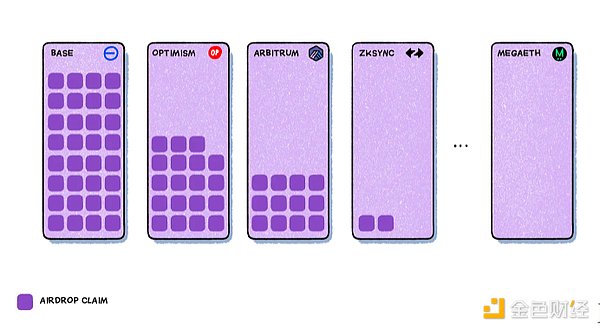
From the user's perspective, none of this matters. Once their claim is complete, they will only see the balance of the airdropped tokens, without knowing which chain their tokens are on.
While this vision of the future remains idealistic and likely depends on years of foundational work, the implications are enormous. As blockchains become commoditized, applications will no longer exhibit a "consistency" or cultural bias toward one chain or ecosystem, but will flow freely between multiple chains or ecosystems. If this happens, the fat protocol theory we discussed earlier will no longer hold true. Instead, the application layer will begin to accrue more value, just like Web2 today.
 This change requires a re-planning of many core aspects of the crypto industry, not just value accumulation. As the rich premiums for protocols decline, investors will begin to allocate funds to applications. Most of the tribal communities that currently exist around blockchains may begin to shift their allegiances toward the product. MEV is currently owned primarily by validators; this equation may change as well.
This change requires a re-planning of many core aspects of the crypto industry, not just value accumulation. As the rich premiums for protocols decline, investors will begin to allocate funds to applications. Most of the tribal communities that currently exist around blockchains may begin to shift their allegiances toward the product. MEV is currently owned primarily by validators; this equation may change as well.
Finally, in contrast to the current thousand-chain landscape, we may see eventual consolidation. Many chains may die out due to low differentiation and reduced financial incentives, leaving only a few that will benefit from the power law and become the backbone of Web3 (just like the few hyperscalers and a long list of specialized providers that serve the network today).
August 1, 2028.
You wake up to find your paycheck has arrived. Great! You made your monthly DCA investment and paid off a small loan. Then you browse X to catch up on the latest election news. Of course, there’s another twist. You quickly think about what it means and recalibrate your election prediction bets. You’re ready to go to work.
On the way, you stop for a cup of coffee and pay with your phone. The barista tells you that you’ve accumulated enough points to get a free snack. Great! As you leave the coffee shop, you see a billboard announcing that your favorite show is about to start a new season. You scan the QR code, minting another digital collectible to add to your existing collection - it gives you the chance to meet the cast.
After get off work, you meet up with a few friends for drinks to watch a football game. As the conversation heats up, you start placing bets on the outcome of the game and who will score the goal. After the game, your friend helps you pay for the bet and the meal, and you give him your share.
With a few drinks to go, you take a cab home. Once you get home, you play the game you've been obsessed with for the past month. Someone offers to buy the sword you collected after yesterday's battle. It seems like a fair offer, and you have a more powerful sword. You sell it.
After a while, you get bored with the game. You also get bored with the art in the digital photo frame on your wall. You want something new. You browse the art market and find something you like. You buy it, and the art on your wall changes.
Finally, you complete your daily check-in with your AI therapist. Once you hang up, some of the points you purchased are deducted.
As you lie in bed and review the day, you realize how many financial transactions you made. In fact, they all happened on the blockchain, and there were a lot of different transactions. Yet, you never noticed. If you were not familiar with cryptocurrency, you wouldn't even think about it now. Your mind goes back to how complicated things were just a few years ago.
You breathe a sigh of relief.
You silently thank the chain abstraction.
The convenience and choice that Netflix’s move from physical DVD rentals to digital and streaming services enabled it to surpass Blockbuster.
 JinseFinance
JinseFinanceStarknet is a zero-knowledge (zk) Rollup.
 JinseFinance
JinseFinanceYou may have seen the hype surrounding the Farcaster. This decentralized social network has taken the crypto space by storm and has grown exponentially in the weeks since Frames was released.
 JinseFinance
JinseFinanceIf you’re a long-time reader of WASD or a dedicated on-chain gamer, you’ve probably heard of Loot Survivor, a rougelike survival game developed by Bibliotheca DAO on Starknet.
 JinseFinance
JinseFinanceGames, Blockchain, AW Frontier: The Rise of the Composable World Exciting new design trends emerge in Golden Finance, full-chain games and AW fields
 JinseFinance
JinseFinanceAmazon's Titan AI suite on AWS introduces a powerful image generator and the "Q" language model, enhancing business-focused AI applications with realism and versatility.
 YouQuan
YouQuanImmutable's collaboration with AWS ushers in a new era of possibilities for blockchain gaming.
 Bitcoinworld
BitcoinworldFTX's storing of private keys for its crypto wallets on AWS has brought attention to the potential risks of disorganized storage of billions of dollars worth of cryptocurrency assets.
 CryptoSlate
CryptoSlateAt SmartCon 2022, Chainlink Co-founder Sergey Nazarov unveils plans to launch staking in December, plus a new economic model for the Web3 services platform.
 Others
OthersOn Dec. 7, dYdX was down, along with Binance.US and Coinbase, due to issues with AWS, leaving traders to wait.
 Cointelegraph
Cointelegraph